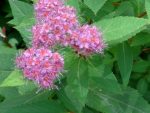 Also known as Japanese meadowsweet, Japanese spirea is native to riparian areas, bogs, and other wetland habitats in Japan, China, and Korea but was introduced into North America as an ornamental and first cultivated in the Northeast about 1870. It has naturalized in the Northeast, Southeast, and Midwest and is now considered invasive in Maine and Michigan, south to Georgia and Tennessee because of his high rate of seed production and tendency to sucker. This deciduous shrub grows 4-6’ tall and is a member of the rose family, Rosaceae, that also includes cherries, pyracantha, and lady’s mantle. It has oval, sharply toothed leaves up to 3” long and flat clusters of tiny pink flowers in late spring to mid-summer. Because flowers are produced on new growth deadheading can encourage continued flowering. Many varieties/cultivars are available that vary most significantly in foliage color and height. The generic name spirea comes from the Greek word speira meaning wreath and refers to the flower clusters. The specific epithet, japonica, means of Japan and refers to the country where the plant is native.
Also known as Japanese meadowsweet, Japanese spirea is native to riparian areas, bogs, and other wetland habitats in Japan, China, and Korea but was introduced into North America as an ornamental and first cultivated in the Northeast about 1870. It has naturalized in the Northeast, Southeast, and Midwest and is now considered invasive in Maine and Michigan, south to Georgia and Tennessee because of his high rate of seed production and tendency to sucker. This deciduous shrub grows 4-6’ tall and is a member of the rose family, Rosaceae, that also includes cherries, pyracantha, and lady’s mantle. It has oval, sharply toothed leaves up to 3” long and flat clusters of tiny pink flowers in late spring to mid-summer. Because flowers are produced on new growth deadheading can encourage continued flowering. Many varieties/cultivars are available that vary most significantly in foliage color and height. The generic name spirea comes from the Greek word speira meaning wreath and refers to the flower clusters. The specific epithet, japonica, means of Japan and refers to the country where the plant is native.
Type: Deciduous shrub
Outstanding Feature: Foliage and flowers especially of cultivars
Form: Mounded
Growth Rate: Rapid to moderate
Bloom: Flat clusters of tiny pink flowers in late spring to mid-summer.
Size: 4-6’ H x 5-7’ W
Light: Full sun but tolerates light shade
Soil: Fertile, moist, well-drained
Hardiness: Zones 4-8
Care: Low maintenance
Pests and Diseases: Generally healthy but susceptible to leaf spot, fire blight, powdery mildew, root rot, aphids, leaf roller, scale
Propagation: Seed
Outstanding Cultivars:
‘Double Play Doozie’ (continuous blooming)
‘Frobelii’ ( bright pink spring flowers; 5’ tall and wide
‘Goldflame’ (orange-gold tinted new growth turning light green in summer, then copper-orange in fall; pink flowers in early summer; 2-3’ tall
‘Little Princess’ (2’ tall and 3 feet wide; rose pink flowers in spring